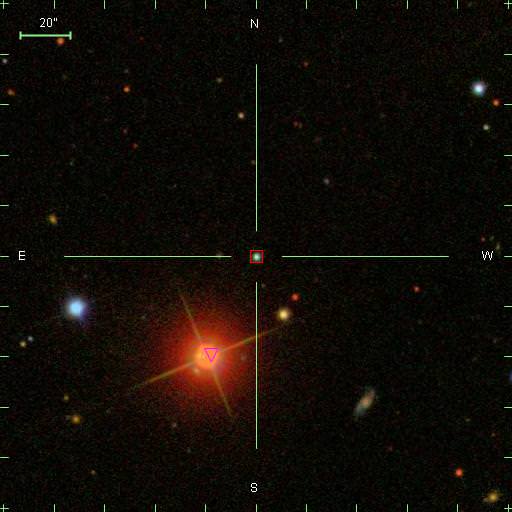Mitch's Mystery Star, Curiouser and Curiouser
<snip>
But I digress; what, exactly, did mitch discover? Judge for yourself; here's the spectrum of the star in question (it goes by the instantly recognizable name 587739406764540066):

<snip>
"Can we rule out something along the line of sight, possibly a cold molecular cloud?" EigenState wrote; "If both stars are moving SE (towards the bottom left corner), could Mitch's star (square) be affected by debris in the trail of the bright red star (triangle)? I am thinking of the trail left by Mira. So the spectrum would be white dwarf shining through cooled red star debris?" said Budgieye. NGC3314 continued "It can't be like our current Oort Cloud since we don't see local absorption from our own in front of lots of stars near the ecliptic plane. To show up this strongly, it would then have to be either much denser or physical much smaller. This just in this may be the most extreme known example of a DZ white dwarf, which have surface metals. White dwarfs aren't supposed to, because their intense surface gravity will generally sort atmospheric atoms by density, so this has been suggested (with some theoretical backing) to result from accretion either from circumstellar or interstellar material (so it could be at the star's surface but representing material formerly in a surrounding disk). Watch this space
"

<snip>
Somehow yet another astronomer, Fergal Mullally heard about mitch's mystery star and joined in too "Many other WDs with strong metal absorption lines are surrounded by a cloud of accretable material. This makes sense because the metals quickly sink below the surface (as mentioned by NGC3314). In some cases, metals are only visible for a few weeks before they are sink too deep to be seen. The disks are exciting, not only because they can be so young, but their composition suggests we might be looking at the remains of an asteroid belt (see
http://arxiv.org/abs/0708.0198)." To which Patrick added "Mitch's Mystery Star is a cool (~4000-5000 K) helium rich white dwarf with traces of metals (abundances similar to G165-7). The metals most probably originate from a tidally disrupted asteroid or minor planet that formed a disk around the star."
<snip>
Two more weeks passed, and a possible reason for Fergal's interest emerges, in a post by NGC3314 "While we wait to see how Patrick's new calculation shakes out, here's an interesting new manuscript he was involved with, that points to likewise interesting things about the DZ stars. [] Wow. White-dwarf spectra as tombstones for planetary systems
wonder how the system stayed close enough to end up on the white-dwarf atmosphere all through the red-giant phases? The binary systems we can see look awfully far apart to have had helpful dynamical effects for this." (in case you didn't read up on Fergal, he's very keen on exoplanets and ET).
More:
http://www.universetoday.com/2010/04/11/mitchs-mystery-star-curiouser-and-curiouser/